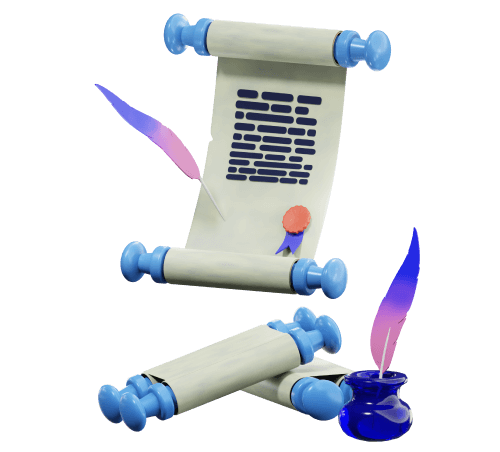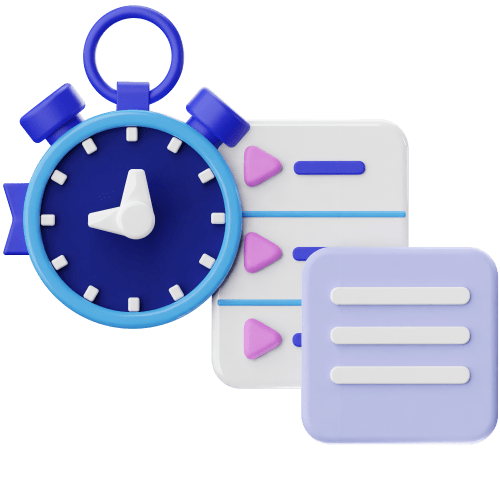Resource Management: Types, Stages, and Optimization Tips
Imagine you’re about to renovate your home. Your ultimate goal would be to get the desired results within the time and budget you have available.
But, to achieve your final outcome, you’ll need to manage:
- Human resources (the specialists involved in renovation),
- Financial resources (the budget available for renovation), and
- Physical resources (materials required for this project).
This scenario is a simplified version of resource management. The reality is that managing resources becomes even more challenging in a business context — especially when managing large or complex projects. To add to the problem, resources, such as talent and money, are often limited.
So, how to do more with less?
You can find the answer in this guide as we cover these points:
- The types of resource management,
- The stages involved in managing resources, and
- Some expert tips to help you optimize your resource management.
Let’s get started.

Table of Contents
What is resource management?
Resource management refers to a set of practices and tools that help businesses make the best use of their resources, such as time, money, and people. The goal of resource management is to ensure the right resources are available at the right time for the right task or project.
Let’s put it another way.
Ever played a video game called Tetris? In this game, players must manipulate falling blocks of different shapes to fit them together efficiently within a confined space. If the blocks pile up and reach the top of the screen, the game ends.
Now, let’s replace the falling blocks with vital resources:
- Time,
- Money,
- People,
- Information, and
- Materials.
Resource management is all about skillfully putting these blocks together efficiently to achieve project success.
For instance, if you are building a house, you will need to put together resources, such as:
- People (contractor or subcontractor),
- Time (2 years),
- Money ($350,000),
- Materials (bricks, tiles, paint, furniture, etc.), and
- Information (knowledge about building permits and safety regulations).
Just as in Tetris, if you don’t manage these resources well, your project (and business) can suffer. The harsh consequences of poor resource management can include financial losses, missed opportunities, and even project failures.
But, how exactly do you master the art of resource management?
Before we get into the strategies, let’s first look at the types and stages of resource management.
What are the 5 types of resource management?
When we talk about the types of resource management, we are essentially talking about managing different types of resources.
As we all know, people, time, and money are the most important resources every business needs. But, you may need other resources for efficient project management, such as raw materials and information.
Let’s look at these resources in some detail.
Type #1: Human resource management (HRM)
As the term suggests, human resource management is all about managing the most important resource of organizations — the human capital. In other words, HRM involves a set of practices and tools a company uses to:
- Employ,
- Compensate,
- Train,
- Nurture, and
- Retain employees.
In their book Human Resource Management: The Key Concepts, authors Chris Rowley and Keith Jackson categorize HRM activities into these four groups:
- Employee resourcing — workforce planning, recruitment, candidate assessment, contracts of employment, and onboarding,
- Employee rewards — compensation strategies, performance evaluation, benefits, motivation, and rewards,
- Employee development — skills development, knowledge transfer, career and leadership development, and
- Employee relations — creating and implementing policies about workplace safety, discrimination and bullying, time tracking, legal compliance, work-life balance.
The purpose of HRM is to nurture and engage employees. According to Gartner’s research, a nurturing environment can then help businesses:
- Achieve organizational goals,
- Manage other resources (such as money, materials, and data),
- Boost productivity,
- Retain top talent,
- Enhance customer satisfaction, and
- Improve revenue growth.
🎓 Clockify Pro Tip
Transform the way you manage your in-house and remote workforce with expert tips and insights. Get started with this blog post now:
Type #2: Financial resource management (FRM)
Financial resource management involves efficient handling of a business’ cash flow and other assets. Financial resources can include both:
- Internal resources — profits generated by sales, capital funding, investments, and assets that can be converted into cash, and
- External resources — credit and loans from banks, government agencies, and other external sources.
FRM includes the following activities:
- Budgeting — setting financial plans and limits for income and expenditures,
- Financial planning and forecasting — creating strategies for future financial performance,
- Cost control — reducing expenses to ensure the business stays profitable,
- Bookkeeping and accounting — recording, analyzing, and reporting financial transactions,
- Resource allocation — allocating funds and assets to different departments within an organization,
- Financial risk assessment — evaluating potential financial threats and developing strategies to manage them,
- Asset management — monitoring and managing the inventory to maximize return on investment, and
- Regulatory compliance — adhering to legal and industry-specific financial regulations and standards.
The main goal of FRM is to ensure the business uses its cash and assets to stay profitable and competitive. This is more important than ever with lack of cash flow being the top reason for business failure, according to a 2022 Skynova survey.
On top of that, a different study found that 65.2% of businesses stayed profitable by optimizing their cash management practices.
These findings highlight the importance of effective FRM that helps businesses maximize their profitability and stay competitive.
🎓 Clockify Pro Tip
Discover easy ways to track and take control of your expenses. Click here to learn more.
Type #3: Time resource management (TRM)
Next up in our list is time management, which involves tools and strategies to make the most efficient use of time.
TRM involves the following activities and processes:
- Goal-setting — prioritizing and focusing on essential tasks and goals,
- Task scheduling — allocating time to activities to ensure each moment is purposefully assigned,
- Streamlining processes — reducing complexity to help utilize time efficiently,
- Promoting time discipline — encouraging a culture where everyone values efficient time management,
- Adjusting workloads and priorities — using feedback to optimize workloads and schedules to boost productivity, and
- Tracking time — using time tracking apps to measure progress and allocate resources.
On top of all the other benefits each time management strategy comes with, time management techniques can also help individuals and organizations reduce procrastination and improve productivity.
In fact, a study by Bain & Company found that efficient time management can help improve employee engagement while lowering costs and boosting productivity.
Another study titled Does time management work? A meta-analysis found that time management helps enhance employees’ job performance and well-being.
🎓 Clockify Pro Tip
Learn the art and craft of creating project timelines and download free templates. Dive into our in-depth blog post:
Type #4: Information resource management (IRM)
As defined in a research paper on information resource management, “IRM is a complex process involving the planning, developing, controlling, operating, and utilizing of organizational information resources.”
The purpose of IRM is to efficiently manage data resources to achieve business goals. For example, by gathering and analyzing customer purchase history, businesses can create personalized marketing messages to improve customer experience.
In the example we gave above, you saw that a house owner needs to possess specific information, such as knowledge of building permits, price of materials, etc., to complete their project.
Here are the aspects of information resource management:
- Knowledge management — organizing and facilitating access to data in the form of documents, digital content, reports, and intellectual assets,
- Data analytics — making informed decisions based on data and analytics,
- Data cleansing — removing duplicate or unwanted data to improve data quality,
- Maintaining data repositories — creating a centralized database to offer a unified view of the company’s data,
- Data governance — establishing policies and standardized practices related to data management,
- Data security and compliance — protecting critical data by using methods, such as access control, encryption, and other security measures, and
- Information infrastructure — managing the tools that store and handle data, such as software, hardware, and network resources.
Type #5: Physical resource management
This type of resource management involves managing your business’ tangible physical assets — office equipment, building, vehicles, and raw materials.
For instance, a business that offers laundry services will need to manage physical resources, such as washing machines, dryers, irons, steamers, tables, etc.
The primary goal of physical resource management is to use these assets efficiently to achieve the desired goals.
These are some of the aspects and activities linked to physical resource management:
- Acquiring resources — purchasing or renting new physical resources as needed,
- Asset maintenance — scheduling regular maintenance to optimize the assets’ functionality and lifespan,
- Inventory control — managing inventory levels to ensure that essential materials and supplies are available when needed,
- Asset tracking — using technology, such as asset tracking systems or software, to monitor the location, condition, and usage of physical resources, and
- Resource optimization — identifying opportunities to enhance the efficiency and cost-effectiveness of physical assets.
What are the stages of resource management?
The stages involved in resource management can depend on the complexity of the project and the type of resources being managed.
For instance, in the case of software product design, it all starts with understanding the project scope, according to Zoran Vizmeg, Project Manager at CAKE.com. He lists the following stages of resource management:
- Step #1: Identifying resource needs — the project team, the product team, and the codebase team discuss the project requirements, complexity, and feasibility.
- Step #2: Assessing and planning resources — with the help of the team, the project manager then creates a project roadmap, defines each task, and estimates the resource requirements.
- Step #3: Allocating resources — the project manager assigns tasks to individual developers or teams.
- Step #4: Scheduling resources — the manager creates a detailed schedule for each task with the help of a scheduling tool, such as Clockify.
- Step #5: Monitoring resources — the project team monitors the project and resources.
- Step #6: Adapting based on feedback — based on feedback from the codebase team, developers, and the project team, the project manager fine tunes resource management.
Thanks to his expertise in project management, Zoran helped us craft the stages of resource management. Let’s look at these various stages involved in resource management in some detail.
Stage 1: Identifying resource needs
In this initial stage, organizations identify the resources required to achieve specific goals or projects. This can include human resources, financial resources, specific materials, equipment, and others.
The following questions can help you identify the resources you need for the project:
- What is the scope of the project (budget, timeline, goals, and deliverables)?
- What resources do we need to successfully complete the project?
- How much of these resources do we need and when do we need them?
- Do we need any external resources, such as specialized equipment or experts?
- What skills are necessary to complete the project tasks?
- How can we access the required resources?
- Do we need backup resources and if yes, where do we find them?
Project managers can use several tools and techniques to estimate project resource needs:
- Expert judgment — consulting experts well-versed in the type of project,
- Alternative analysis — comparing different ways to accomplish tasks and identifying the most suitable or cost-effective resources,
- Published industry data — looking at published data on project resource estimation in industry-specific journals, books, articles, and surveys,
- Project management software — selecting the right software with features that help them find the best combination of resources they need, and
- Historic internal data — drawing insights from the organization’s historical data, such as purchase, time tracking, and accounting records.
🎓 Clockify Pro Tip
Master project cost management and keep your projects on budget. Learn the basics here:
Stage 2: Assessing and planning resources
The next step is to conduct a thorough assessment of required resources. This involves determining the:
- Availability,
- Quantity,
- Quality, and
- Capabilities of the required resources.
If your organization does not have all the resources you need, you may need to invest in the required resources.
For instance, an initial assessment of available human resources helps a company understand if there is a lack of necessary skills for an IT project. The company can now make informed decisions on hiring skilled developers or upskilling its team members.
This is also the stage where project managers create a detailed project roadmap to understand the resource requirements, according to Zoran.
🎓 Clockify Pro Tip
Take your resource planning to the next level with Clockify’s powerful features. Check out this detailed guide:
Stage 3: Allocating resources
Now that you know what resources you need, the next step is to assign them (human, financial, time resources, materials, etc.) to each task or project. The goal of resource allocation is to distribute resources in the best possible way to optimize productivity, lower costs, and achieve the desired results.
For example, a junior graphic designer may need 2 days to complete a design task, while an experienced designer may need only 3 hours. If your design project has a tight deadline, assigning the senior designer is obviously the best way to ensure the task gets completed on time.
As Zoran Vizmeg, our contributor, explains, the third stage of resource management in the IT company means communicating with the development team in order to assign those newly created tasks to developers and confirming estimation.
Here’s a real-world example of successful resource allocation from the book Human Resource Management: Linking Strategy to Practice.
Trader Joe’s, a grocery store, is known for its customer-centric approach. With an aim of making their shoppers happy, they choose employees who are naturally outgoing, upbeat, and have a strong customer focus, in addition to a sense of humor.
Therefore, by allocating their resources the best possible way and selecting the right person for the job, the company gained a competitive advantage and remained profitable.
🎓 Clockify Pro Tip
Maximize project efficiency with resource allocation know-how. Check out this blog post:
Stage 4: Scheduling resources
Resource scheduling involves creating a timeline or schedule explaining when and how you will use resources. This process ensures that resources are allocated at the right time and in the right amounts.
While there are many methods you can use to schedule your resources, two of the most commonly used ones are Gantt chart and Critical Path Method (CPM).
A Gantt chart provides you with a visual representation of your tasks and their timelines.
For example, in the Gantt chart given below, you can see the time taken to complete each task and associated activities. The responsible departments are color-coded along with the assignees for each activity.
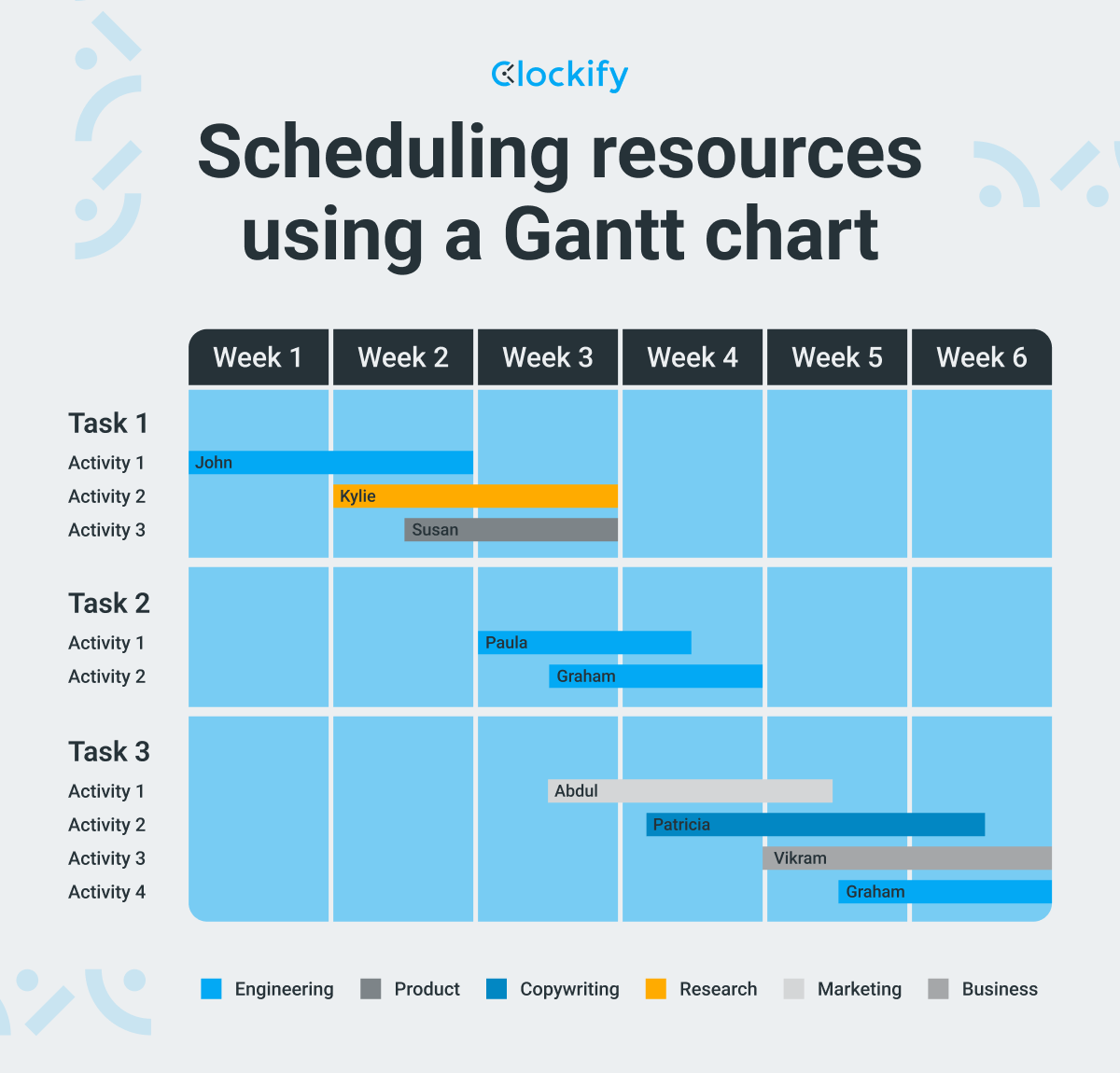
On the other hand, Critical Path Method (CPM) involves identifying the logical sequence of tasks and dependencies in a project. In other words, each project usually consists of multiple tasks, and some tasks may be dependent on other tasks.
For instance, if the project is to build a botanical garden, you cannot plant trees until the site is leveled and soil is prepared.
Stage 5: Monitoring and control
Once resources are allocated and tasks are underway, ongoing monitoring is essential. This process involves:
- Tracking resource usage and project progress, and
- Making adjustments as needed to ensure that goals are met.
According to Zoran, this is also the time when the team “solves bumps on the road that they didn’t see during the planning phase.”
Let’s say a construction project is underway. As the project progresses, the project manager closely monitors how employees use resources. They could use construction timesheets, such as Clockify, to ensure that workers are on-site as scheduled and are productive.
Resource monitoring also includes tracking costs associated with labor, equipment, and materials. If actual costs exceed the budgeted costs for a resource category, the project manager can then take corrective actions. These actions can include measures to identify areas that require cost optimization, seeking approval for budget adjustments, or reallocating resources.
For instance, if the material costs are over budget for a construction project, the project team may decide to use alternative materials to meet the project requirements.
Stage 6: Feedback and adaptation
At defined intervals, organizations need to evaluate the performance and results achieved. This feedback helps improve future resource planning efforts.
Zoran believes communication and constructive feedback are the keys to identifying areas for improvement:

“Communication is important in every part of our lives, especially at work. If we want to grow, we need to get feedback in order to recognise which part of our personal development needs to be improved. If we don’t get any constructive feedback, we can hardly detect what can be improved.”
Sometimes, projects or priorities change, or unforeseen circumstances arise. In such cases, project managers need to reallocate resources to address new needs or challenges.
Based on the evaluation and lessons learned, organizations adapt their resource planning strategies and processes for future projects or planning cycles.
Why is resource management important?
Given that lack of talent, time, and budget are the key obstacles to organizational success, managing these limited resources is more important now than ever.
Let’s see why it’s crucial for project managers and companies to manage their resources properly:
- Improvement in productivity and profitability — when companies use resources efficiently, they can boost productivity and revenue. A McKinsey study shows that firms that prioritize human capital development earn a profit of over $1 million and emerge as “superstars.”
- Securing a competitive advantage — organizations that manage their resources well are often more competitive. For instance, smart data management helped 53% of manufacturers create a competitive advantage for their companies, according to IBM research.
- Increasing employee engagement — making the best use of the time, skills, and competencies of employees can boost morale and job satisfaction.
Yet, most organizations struggle to manage their resources, with the consequences often being profound. In an analysis of 16,000 projects, Bent Flyvbjerg, co-author of How Big Things Get Done, found that just 8.5% of companies were able to stick to their planned budgets and timelines.
Underutilizing resources can also have negative consequences, particularly in big projects. For example, when oil rigs use just 77% of their production resources, the industry suffers a revenue loss of $200 billion each year, according to a McKinsey study.
This brings us to the question: how to improve resource management?
How to improve resource management?
The key to effective resource management is to understand the project’s scope and resource requirements thoroughly. To help you out with that, here are some tips for optimizing resource management.
Tip #1: Be proactive and keep an eye on progress
In the sections above, you learned about the typical stages of a software designing project that Zoran described. By following an established process, Zoran can avoid last-minute scrambles and shortage of resources for any future projects.
While resource managers cannot foresee every possible outcome, being proactive and planning ahead can help them manage resources wisely.
One way to manage resources efficiently is to create a resource management policy. Here are some questions that your resource management policy needs to address:
- Who is responsible for managing resources?
- How will you assess resource requirements?
- How will you allocate resources?
- What procedures will you put in place to address resource shortages?
- What tools will you use to monitor resource utilization?
Another way to be proactive is to anticipate future resource needs.
An easy way to anticipate future resource needs is to use a project forecasting tool such as Clockify. The software uses current data on budget, time, and schedules to make predictions about how the project is likely to perform in the future.
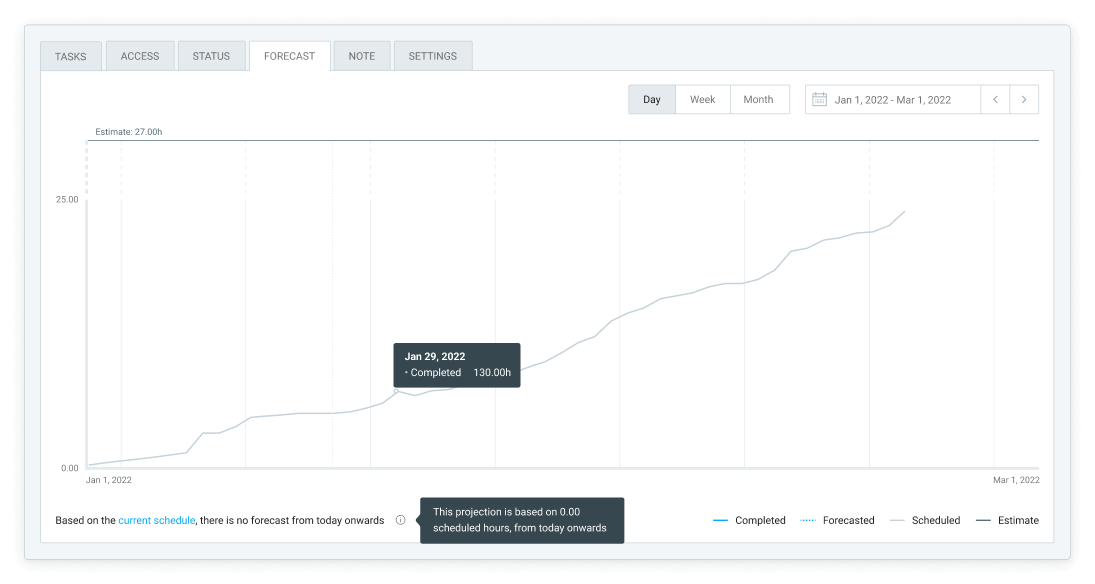
In Clockify, you can keep an eye on project progress
In fact, a case study on streamlining resource management further confirms the importance of estimating future resource needs.
Namely, an IT company owner sets the monthly estimates for projects at the beginning of each month which helps them forecast the hours of work the team needs to achieve these estimates. This habit helps the owner know exactly how the project is going and whether it is taking up more time than expected. It also helps establish a time management culture in the company.
Tip #2: Foster open communication and coordination
While resource or project managers are typically accountable for resource management, it is important to involve all stakeholders in the process. Depending on the type of project, the stakeholders can include the project team, HR, finance, and purchase departments.
In addition to creating a collaborative environment, it is important to encourage ongoing communication between these stakeholders.
Ongoing communication makes it easy for team members to share resource needs, challenges, and ideas to improve resource management.
According to Michael Shick, PMP and assistant professor of project management at Western Carolina University, the foundation for open communication needs to be set in the project initiation stage:

“Open communication and feedback helps to decrease misunderstandings, which in turn should promote enhanced work performance and productivity. Additionally, open communication helps to build trust and fosters understanding, suggesting the significance of open dialogue.”
We can see how important ongoing communication and coordination is by looking at the often quoted example of the Airbus A380 (the world’s largest passenger airplane) project.
Airbus had hired multiple design teams and component manufacturers spread across countries to manufacture Airbus A380. A lack of clear and transparent communication between various teams led to multiple issues during the aircraft’s production. As a result, the project suffered delays, cost overruns, material, and manpower shortages.
Tip #3: Track and monitor resource utilization on a regular basis
Resource monitoring and control play a vital role in ensuring that you are utilizing the resources in the best possible way.
But how frequently should you monitor resource utilization? A survey on resource utilization by the Resource Management Institute (RMI) shows that most organizations measure resource utilization on a weekly or monthly basis. This is also a recommended practice.
Regular monitoring is also a great way of preventing issues, such as underutilization or overutilization of resources and resource-related delays or cost overruns.
For example, by monitoring overtime hours, companies can identify how they distribute overtime and whether some employees can take over more work so that others don’t work overtime. This can help prevent burnout and keep employees motivated.
In addition, tracking the time spent on each task can easily help identify wasted time and make additional changes where needed.
Tip #4: Train resource managers
Resource managers need to have a broad skill set — ranging from project management related skills to the ability to communicate and manage people.
However, RMI’s survey titled Profession of Being an RM/RMO Leader shows that 92% of organizations find it hard or very hard to find skilled resource managers. And, this is one of the key factors that can hamper effective resource management.
The good news is, like most other skills, learning and practicing are the keys to mastering resource management.
By investing in resource management training, organizations can empower their workforce with the essential skill sets. These training initiatives can include:
- Courses in resource allocation methodologies,
- Project management frameworks, and
- Soft skills development.
According to Elizabeth Harrin, experienced project manager and author of Managing Multiple Projects, one of the biggest challenges lies in making sure all members of the team, particularly the less experienced, have the opportunity to learn.

“We’d all like the best, most experienced, well-trained people to be on our projects, but that would mean junior and less experienced people would never get a chance to practice their skills. If you want your staff to stay with you long term, you should look for ways to provide them with experiences that stretch their abilities and help them develop as professionals.”
How to manage resources with Clockify
Why do you need tools such as Clockify to manage resources? Here’s a compelling reason — the above-mentioned RMI’s survey on resource utilization found that the lack of automation tools is one of the biggest inhibitors of effective resource management.
Surprisingly, 57% of survey respondents said they rely on spreadsheets for resource management despite the availability of resource management tools.
As a resource management software, Clockify streamlines various aspects of resource management. From scheduling tasks to tracking project progress, there are many features that help you fast-track resource management. Let’s see how.
Clockify enables you to plan and visualize your projects and milestones. You can:
- Organize your projects by clients,
- Create tasks within these projects, and
- Define the timelines for each task and project.
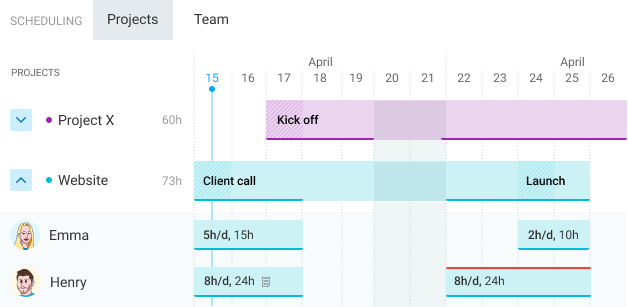
With Clockify, you can quickly determine who on your team is busy and who is available for new assignments. Later on, you can easily assign new tasks and define work schedules. This visibility is crucial for resource allocation and ensuring that work is evenly distributed.
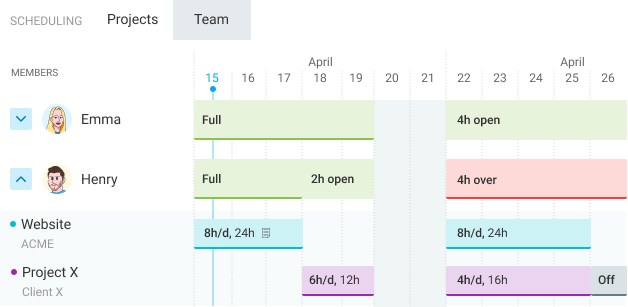
Clockify offers time tracking capabilities — allowing your team to log their hours accurately. This feature helps you monitor work progress, productivity, and time utilization.
This tool also allows you to set budgets for each task and project. You can then track and compare the actual versus estimated time and expenses to optimize resource management.
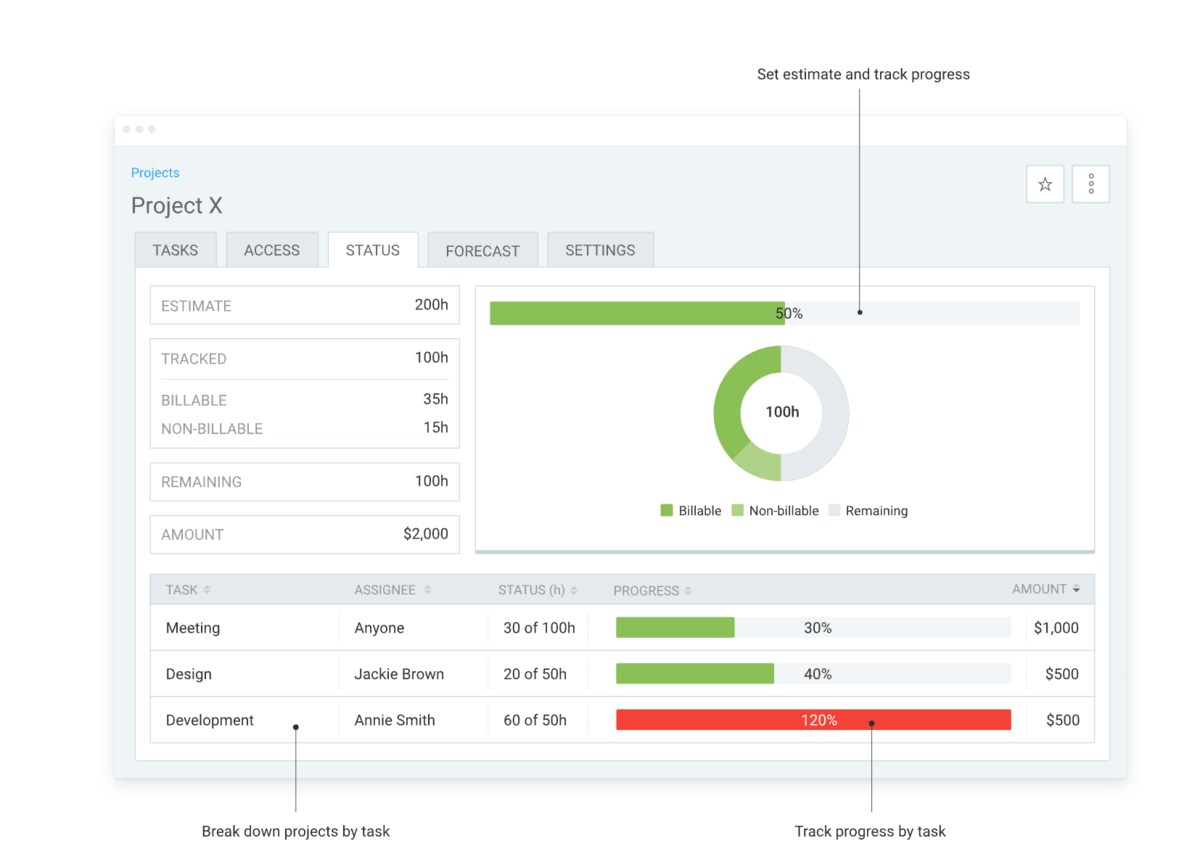
Conclusion: Plan ahead and track to optimize resource management
Given the constraints of time, money, and talent in today’s business landscape, effective resource management is the key to project success.
To ensure you’re making the most of your resources, remember to:
- Understand the project scope,
- Plan ahead,
- Allocate wisely, and
- Continuously track resource usage.
By implementing the strategies we’ve listed, not only can you optimize resource management, but you can also boost productivity and gain a competitive edge.
Above all, be strategically hawk-eyed on your resources and invest in training resource managers. Now, you’ll be well on your way to achieving your organizational goals.
